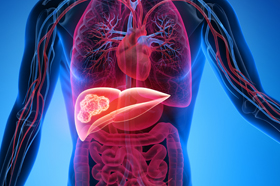Study Reports a High Financial Burden for Medicare Patients With Liver Cancer
 An analysis led by a researcher at UT Southwestern Medical Center has found that hepatocellular carcinoma (HCC), the most common type of liver cancer, can place a significant financial burden on patients. The study, which looked at costs for patients with HCC in the first year after diagnosis, found that median Medicare payments exceeded $65,000 and out-of-pocket costs were more than $10,000 – significantly more than costs for patients with cirrhosis alone.
An analysis led by a researcher at UT Southwestern Medical Center has found that hepatocellular carcinoma (HCC), the most common type of liver cancer, can place a significant financial burden on patients. The study, which looked at costs for patients with HCC in the first year after diagnosis, found that median Medicare payments exceeded $65,000 and out-of-pocket costs were more than $10,000 – significantly more than costs for patients with cirrhosis alone.
The study published in Clinical Gastroenterology and Hepatology was led by Amit Singal, MD, Professor of Internal Medicine in the Division of Digestive and Liver Diseases and a member of the Harold C. Simmons Comprehensive Cancer Center at UT Southwestern.
“As has been shown for other cancer types, we found patients with liver cancer suffer from high cancer-related financial burden. Financial toxicity of cancer therapy can negatively impact patients, resulting in medical debt and even bankruptcy for some patients,” said Dr Singal, Medical Director of UTSW's Liver Tumor Program and a Dedman Family Scholar in Clinical Care.
The total cost of cancer treatment in the United States is expected to reach nearly $250 billion by 2030. The team chose to investigate outcomes in liver cancer given its rising incidence and mortality rate. Liver cancer mortality is accelerating, in part due to continued detection at late stages, and it is expected to be the third-leading cause of cancer deaths by 2040, according to Dr Singal and his team.
The cost of liver cancer treatment has been little studied, the researchers said. Several treatments have become available for patients in the past decade, including new surgeries, radiation-based therapies, and immunotherapies, making it essential to understand the financial impact of treatment. Although these therapies can be effective, they also can be quite expensive and difficult for patients to afford.
Using data from the Surveillance, Epidemiology, and End Results (SEER) Medicare database, the study looked at first-year treatment costs for 4,525 patients ages 68 and older who were diagnosed with liver cancer between 2011 and 2015. The study compared costs for patients with HCC with those for a matched set of patients with cirrhosis.
Sixty-seven percent of the patients in the study were male; 72% were white, 7.5% Black, 3.7% Hispanic, and 16.7% other ethnicities. Medication claims were not included because they were not available for all patients covered by Medicare parts A and B.
The analysis found that patients with liver cancer had significantly higher inpatient, outpatient, and physician costs compared with the cirrhosis-only patients. Median out-of-pocket costs for the first year of treatment were more than $7,000 higher than the costs for the cirrhosis patients.
The analysis found that patients with early-stage liver cancer had lower costs. Patients with certain co-existing conditions, such as non-alcoholic fatty liver disease and ascites (fluid in the abdomen), experienced higher costs. These differences in costs across subgroups are notable because most patients are found beyond an early stage, and non-alcoholic fatty liver disease is an increasingly common underlying factor for liver cancer.
“Our data highlight that HCC care not only causes considerable financial stress on the health care system but directly for patients and their family members, who suffer from high out-of-pocket costs. There is a clear need for policy interventions and financial support systems in this patient population,” said Dr Singal.